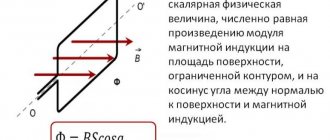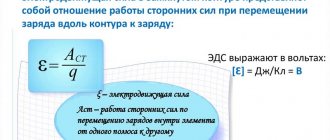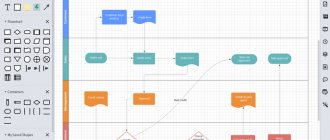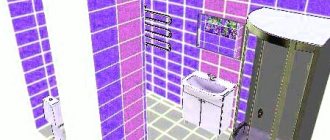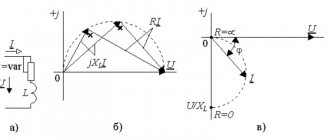Vector diagrams and complex representation
Vector diagrams can be considered a variant (and illustration) of representing oscillations as complex numbers. With this comparison, the Ox axis corresponds to the axis of real numbers, and the Oy axis corresponds to the axis of purely imaginary numbers (the positive unit vector along which is the imaginary unit).
Then a vector of length A
, rotating in a complex plane with a constant angular velocity
ω
with an initial angle
φ0
will be written as a complex number
and its real part
-there is a harmonic oscillation with a cyclic frequency ω
and the initial phase
φ0
.
Although, as can be seen from the above, vector diagrams and a complex representation of oscillations are closely related and essentially represent variants or different sides of the same method, they nevertheless have their own characteristics and can be used separately.
- The method of vector diagrams can be presented separately in courses in electrical engineering or elementary physics if, for one reason or another (usually related to the moderate level of mathematical preparation of students and lack of time), it is necessary to avoid the use of complex numbers (explicitly) at all.
- The complex presentation method (which, if necessary or desired, can also include a graphical presentation, which, however, is completely unnecessary and sometimes unnecessary) is generally more powerful, because naturally includes, for example, the compilation and solution of systems of equations of any complexity, while the method of vector diagrams in its pure form is still limited to tasks involving summation, which can be depicted in one drawing.
- However, the method of vector diagrams (in its pure form or as a graphical component of the complex representation method) is more visual, and therefore, in some cases, potentially more reliable (allows, to some extent, to avoid gross random errors that can occur in abstract algebraic calculations) and allows In some cases, to achieve, in some sense, a deeper understanding of the problem.
Crello
The online graphic editor is designed for everyone who regularly needs to create a visual diagram for work without spending a lot of time. Crello has more than 30 thousand unique templates - among them you will find bright designer diagrams, and edit them for your desired purposes. You can add images, shapes, stickers, lines, and other design objects from a giant media library.
When the diagram is ready, you can download it in the desired format or immediately share it on social networks from the Crello interface.
Features of Crello:
- A library of ready-made design templates for constructing a diagram.
- A clear interface that you can quickly understand.
- Over 60 million ready-made images to complement your project.
- Create a diagram in a few clicks.
Types of vector diagrams
Vector graphics are well suited for correctly displaying variables that determine the functionality of radio devices. This implies a corresponding change in the basic parameters of the signal along a standard sinusoidal (cosine) curve. To visualize the process, harmonic oscillation is represented as a projection of a vector onto the coordinate axis.
Using standard formulas, it is easy to calculate the length, which will be equal to the amplitude at a certain point in time. The tilt angle will indicate the phase. The total influences and corresponding changes in vectors obey the usual rules of geometry.
There are high-quality and accurate diagrams. The first ones are used to take into account mutual connections. They help make a preliminary assessment or are used to completely replace calculations. Others create taking into account the results obtained, which determine the size and direction of individual vectors.
Pie chart
Let us assume that we need to study the change in current parameters in a circuit for different values of resistor resistance in the range from zero to infinity. In this circuit, the output voltage (U) will be equal to the sum of the values (UR and UL) on each of the elements. The inductive nature of the second quantity implies a perpendicular relative position, which is clearly visible in part of figure b). The triangles formed fit perfectly into the 180 degree circle segment. This curve corresponds to all possible points through which the end of the vector UR passes with a corresponding change in electrical resistance. The second diagram c) shows a current lag in phase by an angle of 90°.
Line chart
Shown here is a two-pole element with active and reactive conductivity components (G and jB, respectively). A classic oscillatory circuit created using a parallel circuit has similar parameters. The parameters noted above can be represented by vectors that are constantly located at an angle of 90°. A change in the reactive component is accompanied by a movement of the current vector (I1...I3). The formed line is located perpendicular to U and at a distance Ia from the zero point of the coordinate axis.
Mechanics; harmonic oscillator
- A harmonic oscillator in mechanics and a harmonic oscillator of any nature formally represent an exact analogy, so we will consider them in one paragraph using the example of a mechanical harmonic oscillator.
- The use of vector diagrams in mechanics is reduced mainly to the case of a harmonic oscillator (including the case of an oscillator with a friction force linear in speed); however, vector diagrams can be to some extent useful for studying several oscillators, including in the limit of an infinite number of them (for oscillations or waves in distributed systems).
- From a modern point of view, the application of vector diagrams to a harmonic oscillator is rather of only historical and pedagogical interest, but nevertheless, in principle, they are quite applicable here.
- In mechanics, the use of vector diagrams (usually meaning their application to a one-dimensional oscillator) has the peculiarity that the addition of a second coordinate to transform oscillations into rotation can have not only a purely formal abstract meaning, but for a one-dimensional mechanical system of this kind a mechanical two-dimensional system can be indicated , for which the vector diagram is the first to be realized as a completely real two-dimensional mechanical movement, and all vectors are really two-dimensional (and after projecting all of them and moving a point of a two-dimensional system onto one axis, we obtain instantaneous values of the corresponding quantities - including positions - for the corresponding one-dimensional system ); Thus, for a mechanical one-dimensional system, not only a formal mathematical, but also a real mechanical
model is possible, transforming oscillatory one-dimensional motion into rotational motion in two-dimensional space, implementing a vector diagram for a one-dimensional system.
Let us examine two main cases of simple application of vector diagrams in mechanics (as noted above, also applicable to a harmonic oscillator not only of mechanical, but of any nature): an oscillator without damping and without external force and an oscillator with (linear) damping (viscosity) and external forcing by force.
Representation of sine functions as complex numbers
A vector diagram is a convenient tool for representing sinusoidal functions of time, which are, for example, voltages and currents of an alternating current electrical circuit.
Consider, for example, an arbitrary current represented as a sine function
i(t) = 10 sin(ωt + 30°).
This sinusoidal signal can be represented as a complex quantity
I = 10∠30°.
To form a complex number, the magnitude and phase of the sinusoidal signal are used.
Vector diagram for series connection of elements
To construct vector diagrams, first compose equations according to Kirchhoff's laws for the electrical circuit in question.
Let's consider the electrical circuit shown in Fig. 1, and draw a vector voltage diagram for it. Let us denote the voltage drop across the elements.
Rice. 1. Series connection of circuit elements
Let's create an equation for this chain according to Kirchhoff's second law:
UR + UL + UC = E.
According to Ohm's law, the voltage drop across the elements is determined by the following expressions:
UR = I ∙ R,
UL = I ∙ jXL,
UC = −I ∙ jXC.
To construct a vector diagram, it is necessary to display the terms given in the equation on the complex plane. Typically, current and voltage vectors are displayed on their own scales: separately for voltages and separately for currents.
From the mathematics course we know that j = 1∠90°, −j = 1∠−90°. Hence, when constructing a vector diagram, multiplying a vector by an imaginary unit j results in a rotation of this vector by 90 degrees counterclockwise, and multiplication by −j results in a rotation of this vector by 90 degrees clockwise.
When constructing a vector diagram of voltages on the complex plane, we will first display the current vector I, after which we will display the voltage drop vectors relative to it (Fig. 2), taking into account the above relations for the imaginary unit.
The voltage drop across the resistor UR coincides in direction with the current I (since UR = I ∙ R, and R is a purely real value or, in simple words, there is no multiplication by an imaginary unit). The voltage drop across the inductive reactance leads the current vector by 90° (since UL = I ∙ jXL, and multiplying by j leads to a rotation of this vector by 90° counterclockwise). The voltage drop across the capacitive reactance lags behind the current vector by 90° (since UC = −I ∙ jXC, and multiplying by −j leads to a rotation of this vector by 90° clockwise).
Rice. 2. Vector diagram of voltages for a series connection of circuit elements. Please note that one vector diagram shows only the vectors of those quantities whose frequency coincides!
Vector diagram for parallel connection of elements
Let's consider the electrical circuit shown in Fig. 3, and draw a vector diagram of currents for it. Let us denote the direction of the currents in the branches.
Rice. 3. Parallel connection of circuit elements
Let's create an equation for this chain according to Kirchhoff's first law:
I – IR – IL – IC = 0,
where
I = IR + IL + IC.
Let us determine the currents in the branches according to Ohm’s law using the following expressions, taking into account that 1 / j = −j:
IR = E/R,
IL = E / (jXL) = −j ∙ E / XL,
IC = E / (−jXC) = j ∙ E / XC,
To construct a vector diagram, it is necessary to display the terms given in the equation on the complex plane.
When constructing a vector diagram of currents on the complex plane, we will first display the EMF vector E, after which we will display the current vectors relative to it (Fig. 4), taking into account the above relations for the imaginary unit.
The current in the resistor IR coincides in direction with the emf E (since IR = E / R, and R is a purely real quantity or, in simple words, there is no multiplication by an imaginary unit). The current in the inductive reactance lags behind the EMF vector by 90° (since IL = −j ∙ E / XL, and multiplying by −j results in a rotation of this vector by 90° clockwise). The current in the capacitive reactance leads the EMF vector by 90° (since IC = j ∙ E / XC, and multiplying by j leads to a rotation of this vector by 90° counterclockwise). The resulting current vector is determined after the geometric addition of all vectors according to the parallelogram rule.
Rice. 4. Vector diagram of currents for parallel connection of circuit elements
For an arbitrary circuit, the algorithm for constructing vector diagrams is similar to the above, taking into account the currents flowing in the branches and the applied voltages.
Please note that the site provides a tool for constructing vector diagrams online for three-phase circuits.
SmartDraw.com
SmartDraw includes over 4,500 templates for over 70 diagram types—each with over 3,400 symbols available to create. It's the only charting app with intelligent formatting, meaning you can delete or move shapes and the chart will automatically resize and maintain its layout.
SmartDraw is suitable for anyone who needs a useful tool for creating organizational charts, flowcharts, and displaying business projects. The application allows you to draw and print architectural and engineering diagrams to scale.
Features of SmartDraw:
- More accessible and easier to use than Microsoft Visio.
- Automatic adjustment of the drawing process.
- Over 4,500 templates and over 70 chart types.
- Integration with PowerPoint, Outlook, WordPress, Microsoft Office.
- Free trial available.
Algorithm for creating a ray vector diagram in Excel
To simplify our lesson, let's assume that we are talking about relationships not between fourteen as in the graph, but for now only with 4 people named Anton, Alice, Boris and Bella.
Our matrix of the level of relationships and connections between them looks like this:
- 0 means no relationship;
- 1 means weak relationship (for example: Anton and Alice just know each other);
- 2 means a strong relationship (for example, Boris and Alisa are friends).
How can we geometrically model the visualization of this raw data? If we were to draw the relationship between these four people (Anton, Alice, Boris and Bella), it would schematically look like this:
2 criteria that we need to determine:
- Location of dots (where people's names are printed).
- Lines (starting and ending points of connecting lines).
Defining and plotting points
First we need to plot our points so that the space between each point is the same. This will create a balanced schedule.
Which geometric figure best satisfies our need for such equal intervals? Of course it's a circle!
You might object that the finished diagram model does not have a circle shape. Yes, really no - that's it. We don't need to draw a circle. We just need to plot the points around it.
So we have 4 stakeholders, we need 4 points:
- If we have 12 stakeholders, we need 12 points.
- If we have 20, we need 20 points.
Assuming the origin of our circle is (x, y), the radius is r and theta is 360 divided by the number of points we need. The first point (x1, y1) on the circle will be at this position:
- x1 = x + r * COS (theta);
- y1 = y + r * SIN (theta).
Once all the points are calculated and connected to the XY chart (scatter plot), let's move on.
Drawing lines on a ray diagram
Let's say we have n people in our network. This means that each person can have a maximum of n-1 relationships.
Thus, the total number of possible lines on our graph is n * (n-1) / 2.
We need to divide it by 2, as if A knows B, then B also knows A. But we only need to draw 1 line.
The network graph analysis ray diagram template is configured to work with 20 people. It can be downloaded at the end of the article and used as a ready-made analytical tool for visualizing these connections. This means that the maximum number of rows we can have will be 190.
Each line requires adding a separate series to the chart. This means we need to add 190 series of data for just 20 people. And it only satisfies one line type (dashed or thick). If we want different lines depending on the type of relationship, we need to add another 190 episodes.
It's painful and funny at the same time. Fortunately, there is a way out!
We can use a much smaller number of series and still produce the same graph.
Let's say we have 4 people - A, B, C and D. For the sake of simplicity, let's assume that the coordinates of these 4 people are as follows:
- A – (0.0);
- B – (0.1);
- C – (1,1);
- D – (1.0).
And let's say A has relationships with B, C and D.
This means that we need to draw 3 lines, from A to B, from A to C and A to D.
Now, instead of putting 3 series for the chart, what if we put one long series that looks like this:
(0,0), (0,1), (0,0), (1,1), (0,0), (1,0)
This means we simply draw one long line from A to B, A to C, A to D. Granted, it's not a straight line, but Excel scatter plots can draw any line if you give it a set of coordinates.
See this illustration to understand the technique:
So instead of 190 series of data for the chart, we just need 20 series.
In the last chart we have 40 + 2 + 1 series of data. It's because:
- 20 lines for weak relationships (dashed lines);
- 20 lines for strong relationships (thick lines);
- 1 line for highlighting in blue the weak relationships of the selected participant;
- 1 line for highlighting in green the strong relationships of the selected participant;
- 1 set without lines, but just dots for data labels on the graph.
How to generate all 20 data series:
This requires the following logic:
- Assuming we need lines for person n's relationships.
- This person's point will be (Xn, Yn) and has already been calculated earlier (at points on the graph around the circle).
- We only need 40 rows of data.
- Every odd row will have (Xn, Yn).
- For each even row:
- divide the line number by 2 to get the person's number (say m>);
- (Xn, Yn) if there is no relationship between n and m>;
- (Xm, Ym) if there are relations.
We need MOD and INDEX formulas to express this logic in Excel.
Once all line coordinates have been calculated, add them to our scatter plot as new series using the tool from the additional menu: “WORKING WITH DIAGRAMS” - “CONSTRUCTOR” - “Select data” in the “Select data source” window, use the “Add” button to adding all 43 rows.
We will implement the creation of such a ray diagram of connections in 3 stages:
- Preparation of initial data.
- Data processing.
- Visualization.
⇡#Autotracer - free raster image to vector converter
When it comes to complex vector graphics, it is sometimes easier not to create them from scratch, but to vectorize the raster image, that is, convert it to a vector format. This process is also called tracing.
Almost any vector editor has the corresponding tools, but vectorization can be even easier thanks to online tools. You can find more than one web service that offers similar services. For example, the free Autotracer resource is very easy to use. It can be used to convert PNG, BMP, JPEG and GIF files into vector format and save into SVG, EPS, PDF, DXF format.
The service is completely free, but there is one limitation: the size of the source file should not exceed one megabyte. Before conversion, you can set some settings: decide on the number of colors that will be left on the raster image before vectorization, as well as get rid of noise, and indicate in which cases lines will be taken as curves. The process itself happens very quickly, so if the quality of the final drawing is not suitable, you can always experiment with the settings and try again.
Preparing data for a ray diagram
As mentioned above, this template will have the ability to visually build connections for up to 20 participants (companies, branches, counterparties, etc.). The template worksheet "Data" provides a table for populating incoming values. For example, let’s fill it out for 14 market participants:
On the same sheet we will create an additional table, which is a matrix of connections of all possible participants, generated by the formula:
With the data preparation completed, we move on to processing.
How to calculate the sum of vectors?
Vectors and matrices in a spreadsheet are stored as arrays.
It is known that the sum of vectors is a vector whose coordinates are equal to the sums of the corresponding coordinates of the original vectors:
To calculate the sum of vectors you need to perform the following sequence of actions:
– Enter the values of the numerical elements of each vector into ranges of cells of the same size.
– Select a range of cells for the calculated result of the same dimension as the original vectors.
– Enter the formula for multiplying ranges into the selected range
– = Vector_Address_1 + Vector_Address_2 Address
– Press the key combination [Ctrl] + [Shift] + [Enter].
Example.
Two vectors are given:
It is required to calculate the sum of these vectors.
Solution:
– To cells in the range A2:A4
Let's enter the values of the coordinates of vector a1, and into the cells of the range
C2:C4
- the coordinates of vector a2.
– Select the cells of the range in which the resulting vector C will be calculated ( E2:E4
) and enter the formula into the selected range:
=A2:A4+C2:C4
– Press the key combination [Ctrl] + [Shift] + [Enter]. In cells in the range E2:E4
the corresponding coordinates of the resulting vector will be calculated.
Mindmeister
MindMeister is an online mind mapping tool that lets you create, develop, and share ideas visually. Available for both Windows and Mac OS users. Along with other services, Mindmeister allows you to create diagrams and share them with colleagues and friends, while making edits and comments.
Creating a mind mapping is very simple: just enter a keyword or topic name in the center of the map, add branches, name each branch, attach ideas and add visual ideas.
Features of Mindmeister:
- Synchronization with MeisterTask, a project management application.
- Ability to upload your own pictures and backgrounds for diagrams.
- Collaborative editing of a diagram with colleagues.
- Integration with Google Drive, as well as Dropbox, Evernote, Twitter, etc.
- There is a free basic plan.
Did you like the article? 0 0
⇡#ZebraTRACE - free guilloche creation
Any banknotes, as well as documents of national importance (diplomas, certificates, certificates, etc.) are easy to recognize at first glance. This “recognizability” of the document design is given by subtle repeating patterns that run throughout the main drawing. Such lines are called guilloche.
Guilloche patterns can be drawn manually in a vector editor, but without special add-ons and skills to create such patterns, this process can take a long time. The free ZebraTRACE utility helps solve such problems.
This program traces images and combines them with a guilloche pattern. ZebraTRACE uses parametric guilloche generation. Each type of pattern that can be created using the application is determined by a mathematical formula. So, if there is a desire and free time for experiments, the user can get unique drawings.
Creating new guilloches is very simple. Try making minor changes to the pattern generation formula, for example changing the coefficient value from 2 to 3, and the pattern will change. For those who do not want to get creative with ZebraTRACE, the program includes a dozen and a half presets with formulas that allow you to obtain the most common guilloches.
